How Remote-how Builds a Strong Team Culture with Twist Threads & Lots of Emojis
By Twist Team

Few companies embody the changing landscape of remote work better than Remote-how. The company advocates for widespread adoption of remote work and offers training for managers and teams on working remotely. An all-remote team themselves, Remote-how has 10 employees and a few part-time designers and content writers spread across North America, Europe, and Asia.
Since Remote-how launched less than three years ago, remote work has broadened from its association with digital nomads and tech startups and become increasingly mainstream, with more and more companies going partly or fully remote.
With the Covid-19 pandemic changing how teams around the world work, the company’s services and expertise are more in demand than ever. In order to manage their program offerings, a growing community, and events they coordinate annually — including a premiere remote work summit — they need a streamlined and organized way to communicate. They settled on Twist as their virtual hub for collaboration.
Adapting to an evolving remote landscape
Remote-how has evolved significantly from its early days, when the company was focused on digital nomadism. Founders and married couple Iwo and Ola Szapar had always loved traveling and together visited 44 countries. A move in 2017 to Austin, Texas, from Poland, “opened our eyes to the remote work revolution going on.”
Then, a “workation” in Mexico inspired them to start a company that would promote the lifestyle they wanted to live: making it possible for full-time job holders like themselves to work from anywhere. Early content was along the lines of “take off your PJs” and “this is how you get productive,” as director of communications and marketing Magda Sowierszenko puts it.
But they began to realize there was a huge need to educate companies on how to practically implement remote work setups so the practice could become more widely accepted. This spurred them to organize the first Remote Future Summit in 2018 with several friends. The interest was bigger than they ever imagined, with 5,000 people registering to learn from leaders of companies like Automattic, Hubspot, Microsoft, Oracle, and Doist (😀).
After the summit, the Remote-how team knew they had to launch an Academy, to make available the wealth of resources they and their guests had shared. As the company became more serious, they ditched email and moved to the team messaging app Twist for their daily communications. They’d used Slack and other communications tools at other jobs, but they liked that Twist was created to encourage asynchronous communication — its design helps distributed team members focus on their work without the expectation they’d respond right away to messages.
“We have a full buy in [from the team] for the story, the tool, and the concept,” says Magda.
“Whatever we’re doing, whatever part of the business is growing, Twist is there to keep us aligned across continents and time zones.”
Remote-how now offers the only certifications of their kind in distributed management and remote HR, taught by leaders from different remote companies (including Doist’s own Head of Business Development Chase Warrington) on topics like maintaining motivation and company culture and goal-setting and taking action. They also organize the Global Work from Home Day in April, which promotes the freedom for people to work where they want.
Most recently, they have begun to offer a three week “fast track” option, after seeing a spike in interest from managers who have been forced by the Covid-19 pandemic to oversee newly remote teams.
They’ve managed to grow their company while “limiting the number of synchronous meetings to an absolute minimum,” says Magda. They have one face-to-face team check-in every two days — a progress video meeting between everyone in Europe and Asia — and cross-functional and project meetings on the other days. Otherwise, the team keeps in touch through Twist and phone calls, when needed.
Remote-how’s growth attests to the company’s flexibility and openness toward experimenting with different projects and adapting to changes in the remote landscape. That’s part of the process, says Magda: “If something isn't working, we're not afraid of letting it go.”
What has remained consistent is their use of Twist as their team communication software.
“Whatever we’re doing, whatever part of the business is growing, Twist is there to keep us aligned across continents and time zones,” Magda says.
Using Twist for diverse communications needs
The Remote-how team stays connected on a variety of projects via Twist. They use it for product development, sales and marketing, managing their Academy, and participating in and moderating their student community. Their channels are public to everyone on the team, except for a private channel called Team Leads, where the four leaders of the company can have more sensitive conversations.
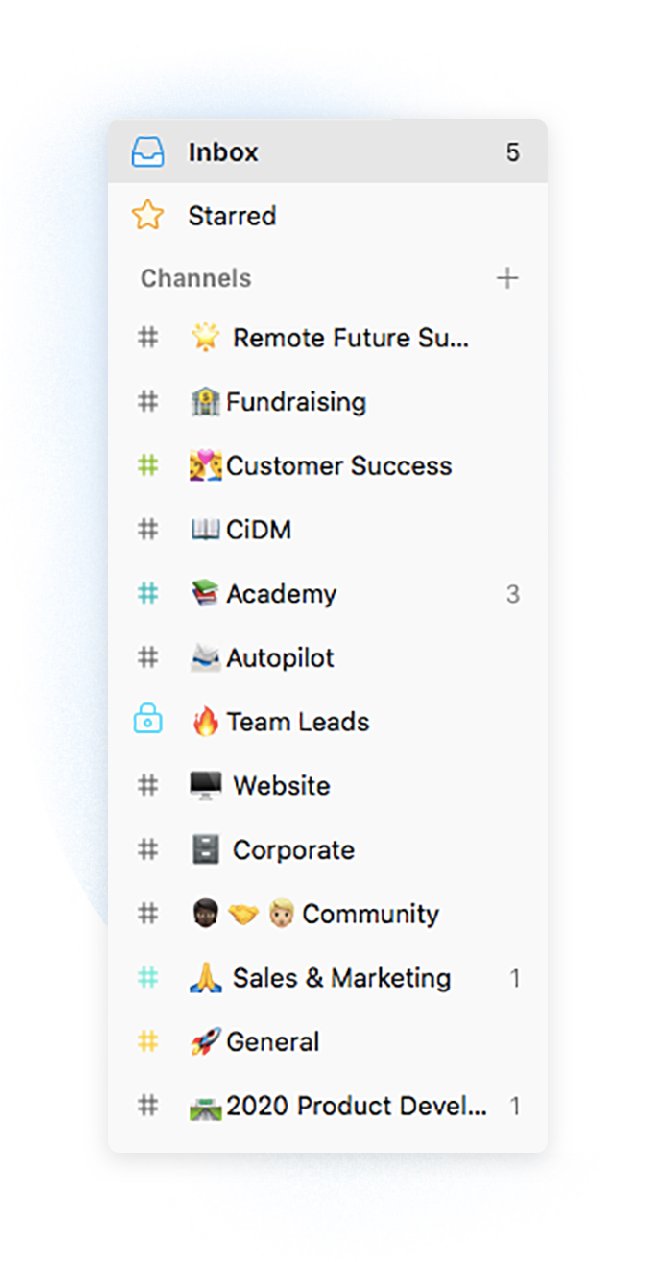
Keeping everything in one place
For anyone enrolled in its online programs, Remote-how runs a Community platform, where participants can stay in touch with one another as part of a growing network and ask instructors questions about remote work. To help them stay responsive to the community, Remote-how has a thread in Twist called “Community Activity,” which is notified any time there are updates or new topics. They used the Twist integration with Zapier to connect the thread with their Community platform, Tribe. Pushing the notifications to Twist means they have fewer apps they have to check regularly.
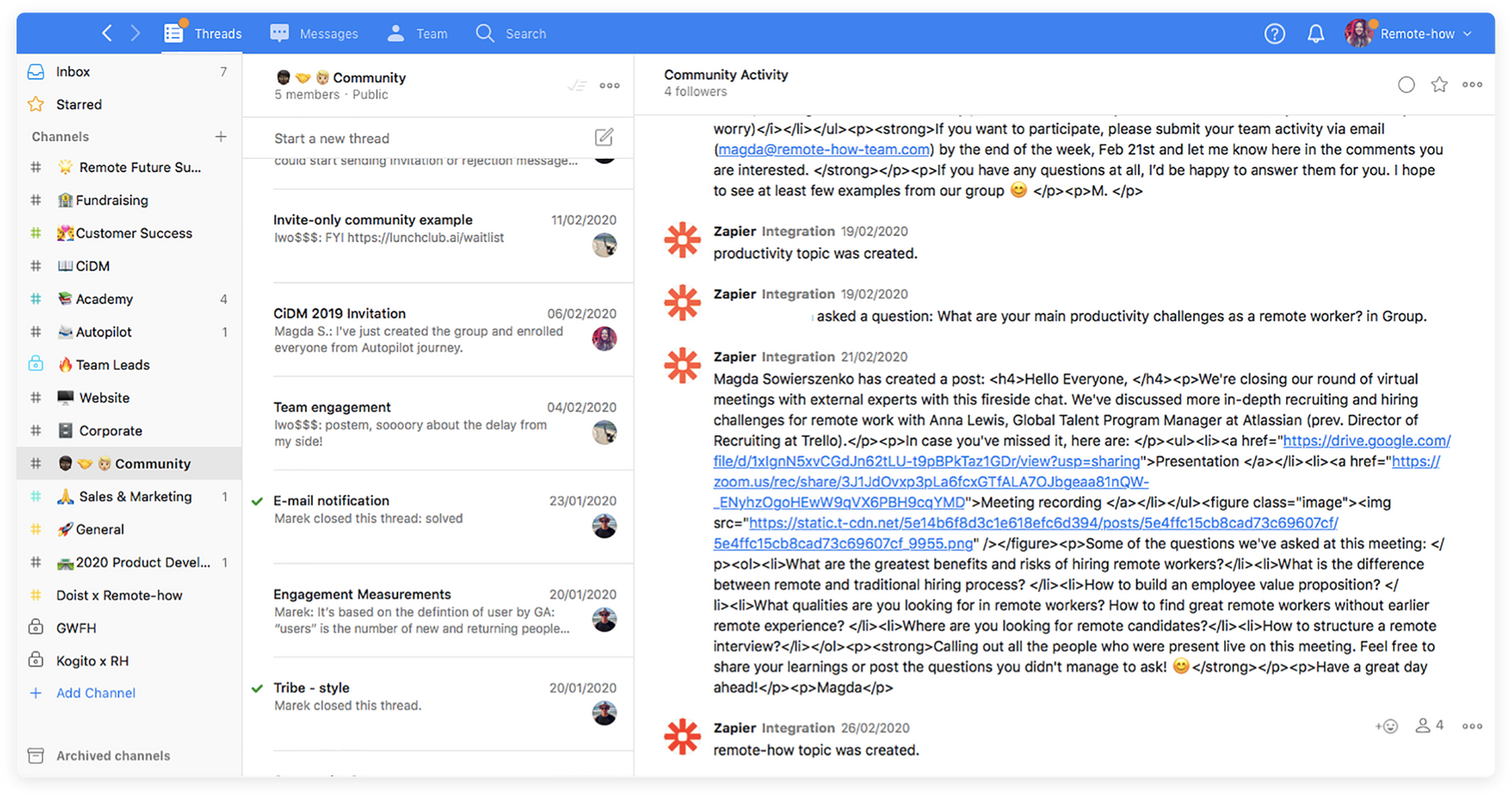
Day-to-day updates and progress
The Remote-how team uses a “daily progress thread” as kind of a ritualistic way for team members to check in at the beginning of the day, and check out at the end of it. This allows everyone to be aware of their progress, and helps put boundaries around the day.
One of the biggest challenges for remote-first companies is creating a cohesive company culture. Remote-how has found that it helps to have informal communication threads, where people can share achievements and just talk. They are big on positive reinforcement, with several threads set up for congratulatory communications, such as “New Customers,” “People Love Us,” and “🎉Kudos.”
"We have a strong emoji culture,” says Magda. The team doesn’t hold back on the 👍, 🙏, 👏, 😄. Here’s how they use emojis:
- Sprinkling a 😄, 🙌, or something else, in threads and messages
- Using 🔥, 🚀, 📚, and more, in the names of channels to further highlight the purpose of each
- Indicating whether someone has read a comment — and taken action on it, in some cases — by reacting to the message with a 👍, 😄, etc.
- Voting on something with a 👍 or 👎
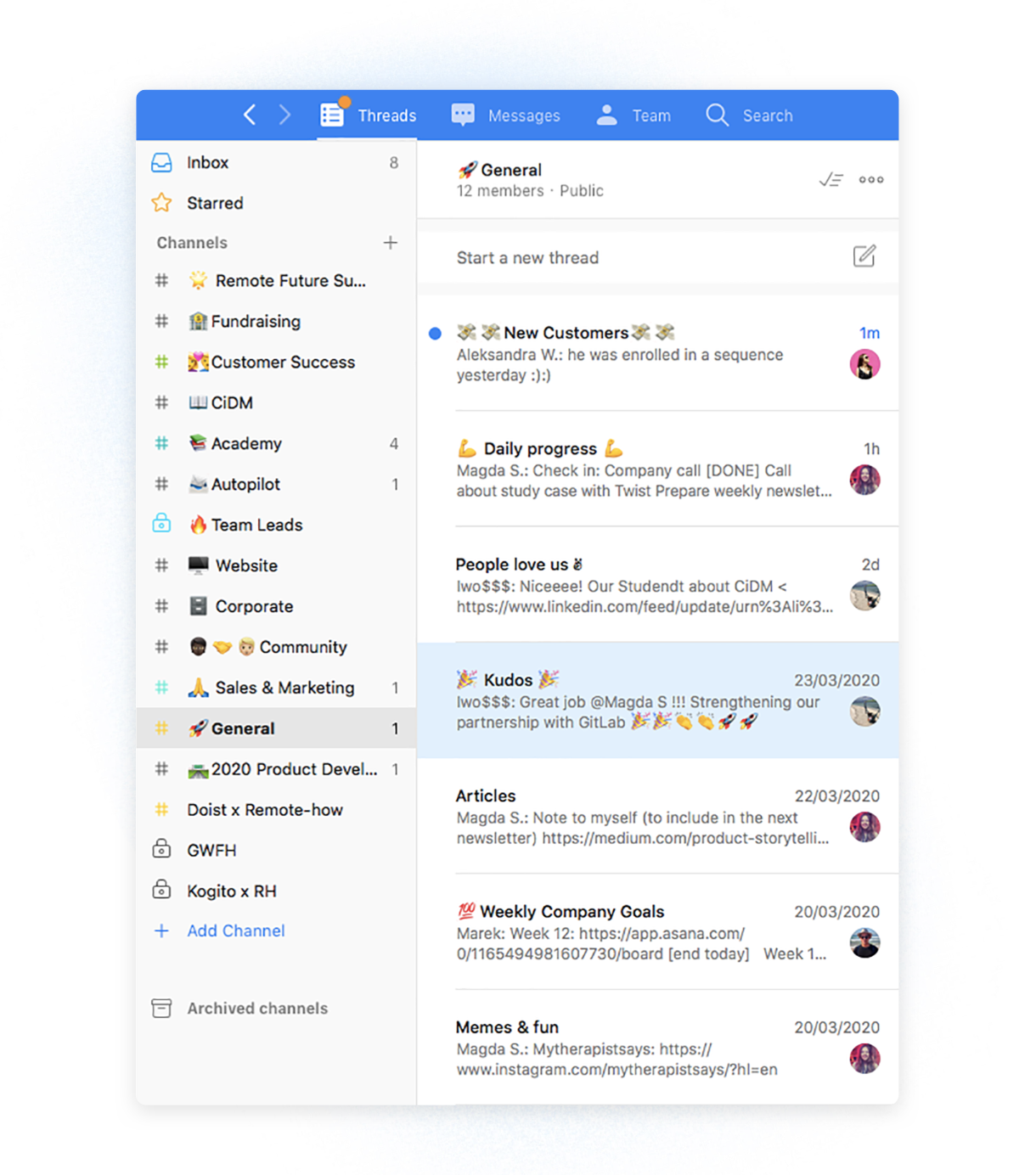
Finishing projects
Remote-how has a pretty minimalist approach to their team communication, with a manageable number of channels. And with the encouragement and initiative of Head of Operations, Marek, they’ve embraced the practice of closing threads and documenting the outcome when they’ve come to an agreement, which limits information overwhelm. “It gives you some mental relief that you’re closing something or coming to an agreement,” says Magda. If there’s a reason to come back to the topic, they can reopen it.
External collaborators
For a widely distributed team like Remote-how, which has a variety of projects going on at any given time, keeping as much of their communication as possible in one place, Twist, is crucial for helping the team stay focused and on the same page. To help with this, Twist allows users to create dedicated channels for projects with external groups. Remote-how has set up a channel with their investors, which they use to keep in touch about significant updates, news about their round series, and other success stories.
We also have a channel between Doist and Remote-how to keep in touch about our collaborations together, which is easy for everyone!
Remote-how’s tips for great remote team communication
To maintain effective communication across several time zones, follow Remote-how’s Twist best practices:
- Outline context. “Asking a question out of the blue makes other people wonder, ‘Why am I being asked this? Is it something wrong that I’ve done?’ says Magda. Start a message with context, such as why you’re asking for something, and if there’s a deadline.
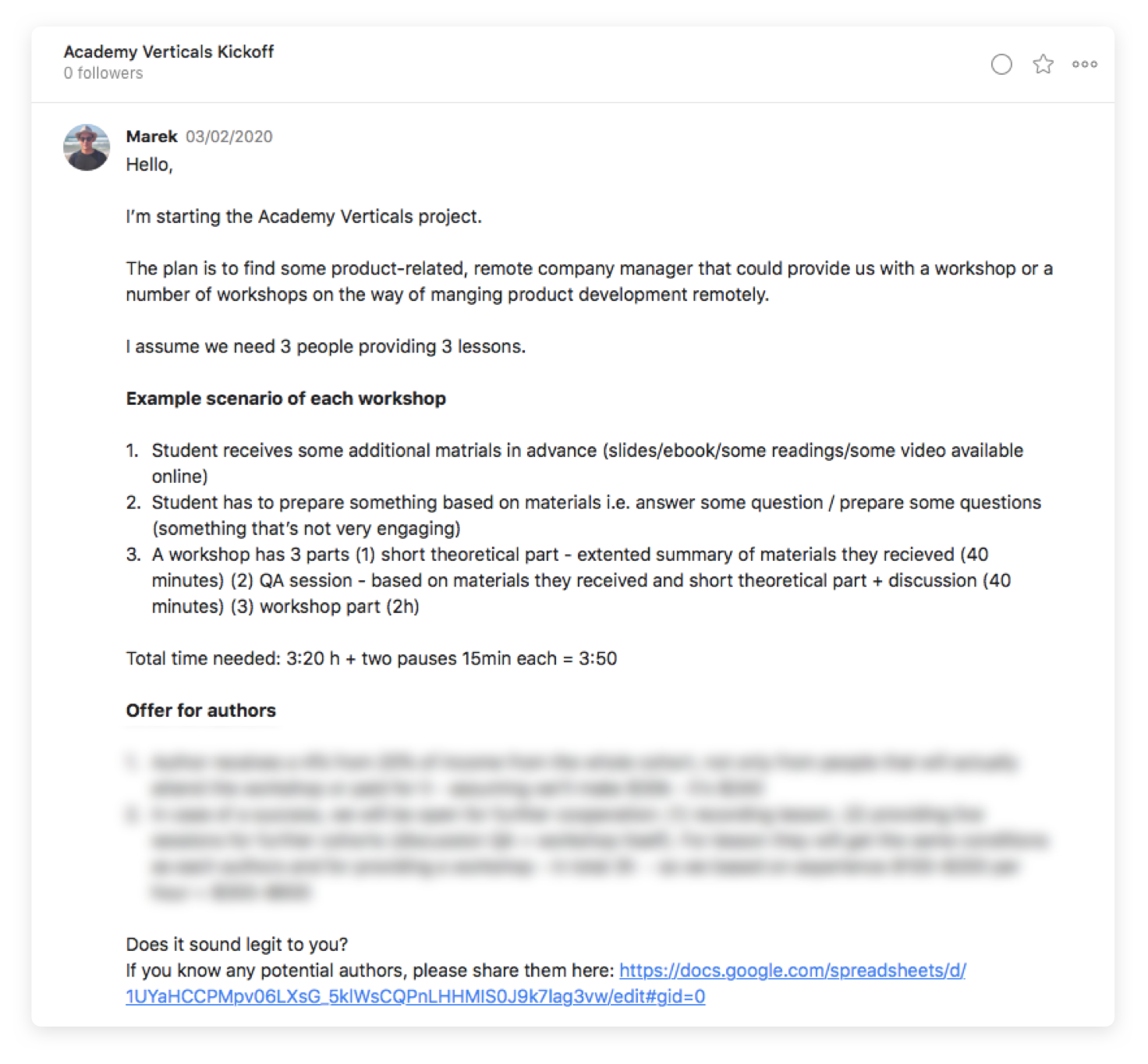
- Do a daily (or weekly) check in and check out. It can be easy to lose track of progress people are making and hard to keep teammates engaged in a remote environment. Have a thread where members say what they’ve accomplished and what they’re working on each day, or each week, to give everyone a sense of the progress that is happening.
- Create threads for congratulatory communications 🎉 about various regular accomplishments in the company, such as individual achievements, media mentions, and new clients. This improves morale and keeps the team aware of new developments.
- Don’t expect an immediate response. Remote-how follows async best practices of not expecting an immediate response to messages. If something is truly urgent, they call each other.
- Promote a strong emoji culture. Since team members can’t see each other for most of a remote work day, try promoting a strong emoji culture. Give each other 👍 when something’s done, 🙏 for appreciation, 👏 for a job well done, and whatever other, 😄 👊 🙌 you choose.
- Close threads. When you’ve made a decision or are done with a project or conversation, close the thread. This helps keep channels uncluttered, making it easier for team members to focus on what’s still active.
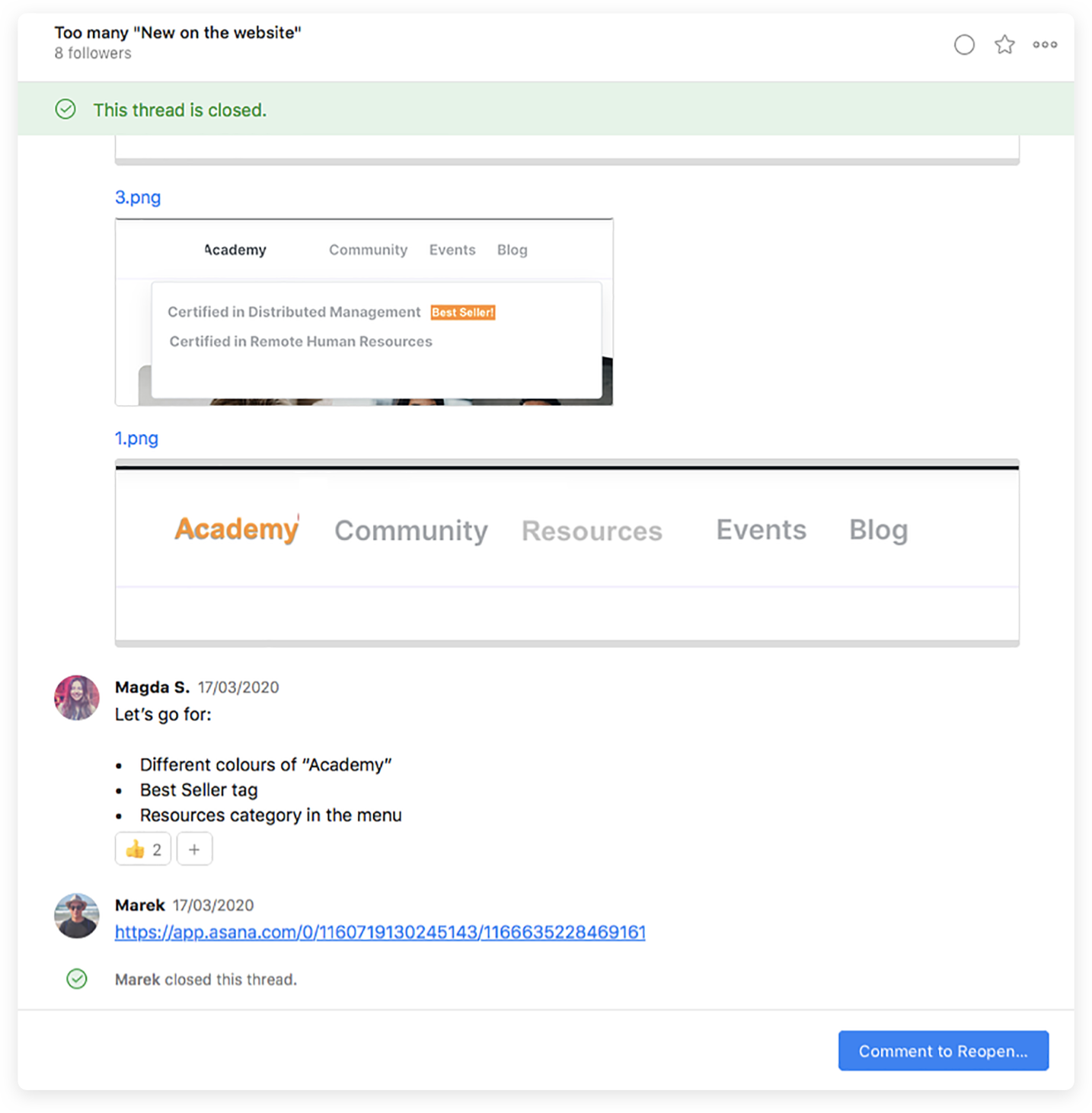
- Use Zapier to create keep notifications in one place. If you have other apps that need to be regularly checked throughout the day, push those notifications into a channel in Twist, using the Twist integration with Zapier. This means you can stay abreast of developments without having to toggle between multiple apps all day.
- Use external channels and workspaces. If you’re working with outside agencies, freelancers, investors, or other external collaborators, you can invite them as guests to Twist and give them access to a specific channel or workspace to stay in touch about projects and keep communications in Twist.
For remote managers who are looking for the ideal team communication tool, Magda recommends that you make a list of specifications that includes: the size of the team, budget, who needs to use the tool, how people need to communicate, and who should have access to team communications, then evaluate the tools available.
She emphasizes, however, that the most important thing, before settling on a chat communication tool, is culture.
“I’m the kind of person that believes, first you have to solve your culture issues, build up on communications skills,” says Magda. “A tool is just a complementary thing. If you don’t have the basics in place, then no tool can ever solve that.”
You don’t need to use Twist to get a ton of value out of this newsletter and community. But if the topics we talk about resonate with you, there’s a good chance the app will too. See what makes Twist different →
🌎 Built asynchronously by the fully remote team at Doist
